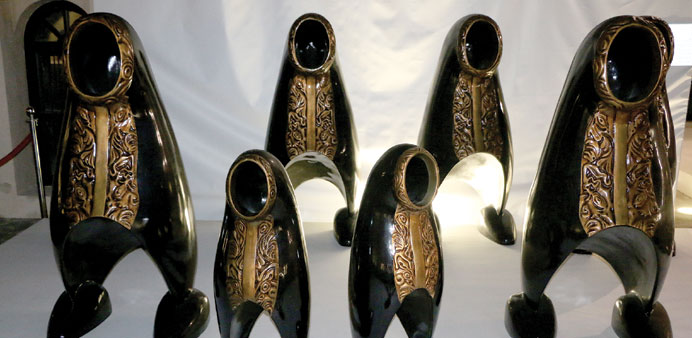By Umer Nangiana
Bukhnuq is a veil worn by girls before marriage and after marriage women wear Batoula. These two attires have been an integral part of female costumes in the GCC countries. Elaborating the difference between the two and the cultures associated with them, talented Qatari artist Fatma al-Shebani came up with life-sized sculptures of the two traditional accessories.
On display at a prominent location behind the Amphitheatre in Katara Cultural Village, the Batoula Exhibition ‘6D’ by Fatma continues to attracts eyeballs as hundreds stroll past them every day. Introducing the two traditional accessories in a very creative and contemporary way, the artist manages to grab the attention of the viewer.
Giving it a passing look, you would stand and stare. The material beauty of the sculptures provokes a curiosity to explore the idea behind the art pieces and to understand the meaning.
The exhibition presents two models of Batoula and Bukhnuq, made from different materials by the artist.
“After my previous exhibitions and my trip between 4D and 5D, my thoughts were turned around like a phonograph CD for everything I passed by since the 70s till today. 6D is traveling through timeline and it is my vertical distance between those circles. It is my return to the past with a new advanced artistic vision,” al-Shebani says, explaining the concept behind the pieces of art.
The two artworks, she says, would help the audience to travel with her to each period and through different modern gates.
“My fear is that these gates might close and we will be disconnected [from the] past. I am still attached to the past and I am working hard to decrease the gap between the past and future,” says al-Shebani.
She says she chose these two artworks as they are connected to each other and wanted to clarify the concept for the audience — that Bukhnuq was worn by a girl before marriage and Batoula was worn after the woman is married.
The purpose of Bukhnuq, the artist explains, was to educate a girl’s modesty and she would keep wearing it until she got married.
“Since my childhood I was touching this black material called AlMalmal, which was thrown on my small body and it was embroidered by gold and silver around my face falling over my whole body.
“I used to comeback late home barefoot and the Bukhnuq was dirty, full of sand in my hand and sometimes I forgot where I used to play,” says the artist.
“I learned how to open it with shyness and covering my face with its small dreams. Today these Bukhnuqs and my beautiful aliens have a different look than those with which I grew up, and I hope to keep them alive in my memories forever,” she adds.
In Arabic history, the Batoula is considered an important part of any woman’s dress and accessories. It was a symbol differentiating between young girls and older women.
“Growing up, I adored older ladies and it was always a pleasure to take a peak under their Batoula to see the faces filled with love and motherhood and of course the purple pigment the Batoula leaves behind on the forehead (allegedly used to protect the skin from ultraviolet light),” recalls the artists in her explanation of the art piece created with stainless steel and mosaic glass.
“I never was able to resist when they would offer me candies and bubblegum and I have always wondered why do they have keys attached and wrapped around the end of their veils,” the artist goes on to explain.
The Batoula sculpture, she said, was created while she was revisiting these memories of her childhood, the simpler life and the beautiful faces that she has seen covered by a mask that holds behind many stories to tell.
In 1994, al-Shebani received her Bachelor degree in Fine Arts from Qatar University. She is part of a number of art associations like the Qatari Association for Plastic Arts, Girl’s Creation Center and Visual Arts Center. She also took part in and completed a number of training courses and workshops, as well as participated in functions and group art exhibitions.
In April 2013, al-Shebani was the first Qatari artist to paint graffiti on the Israel Apartheid Wall (West Bank barrier) along with Palestinian art students from Dar Al-Kalima College. She has held multiple exhibitions outside Qatar in places such as London, Abu Dhabi, Paris and Germany.

Bukhnuq was worn by a girl before marriage with the purpose to educate her modesty, according to the artist.


